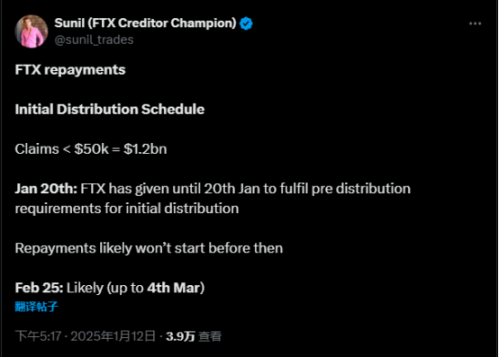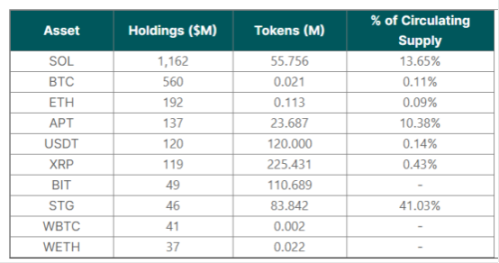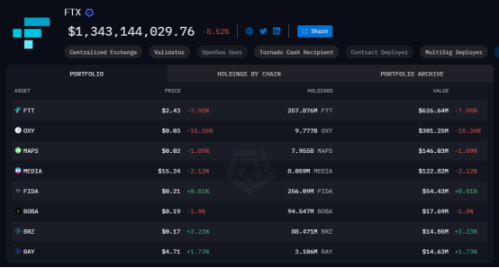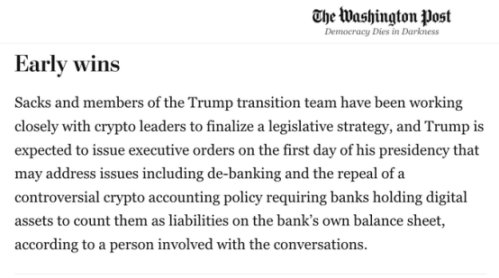While SBF is still eating vegetarian food in prison, FTX, without its boss, has ushered in a new turning point.
After nearly two years of wrangling, and after countless hopes and dreams being shattered, investors’ money finally has a chance to be repaid. On January 3, according to the official announcement of FTX, the FTX debtor reorganization plan officially came into effect. Customers can file a claim through the official website to obtain compensation refunds, and the first round of distribution will be launched within 60 days after the effective date. The initial stage of compensation is about 1.2 billion US dollars. After a long bankruptcy and recovery process, FTX now has 14.7 billion to 16.5 billion US dollars to repay customers and other debtors.
Creditors cheered after the news came out. Although the cash compensation caused them to bear potential losses, the long road to debt collection finally came to an end, and most users were still happy. But for the market, the mixed feelings seem to be more obvious. FTX's compensation means that liquidity may flock to it, but its sell-off fundraising has also cast a shadow on some currencies.
It has to be admitted that this black swan event two years ago still has a profound impact on the crypto market even today.
The FTX incident is undoubtedly a significant negative event in the not-so-long history of cryptocurrencies. At the time, the collapse of FTX swept the entire crypto space, with chain reactions affecting hundreds of crypto companies and hundreds of investment institutions, which not only caused a severe setback in the market, but also completely destroyed the mainstream recognition of cryptocurrencies that had just turned around. On the other hand, the misuse of funds, financial fraud, lottery decisions, and various outrageous operations of SBF and its team also made users extremely angry about being manipulated and fooled.
Back to the debt, on November 12, 2022, SBF announced on social media that more than 130 affiliated companies, including the exchange FTX.com and the affiliated trading company Alameda Research, have voluntarily filed for bankruptcy in accordance with Chapter 11 of the U.S. Bankruptcy Code in order to "evaluate and liquidate assets in an orderly manner in the interests of global stakeholders." Initially, the Wall Street Journal stated that FTX's funding gap was about $8 billion. But as the trial continued, the total amount of claims increased at an alarming rate, and eventually more than 36,000 claims were made, with a total amount of about $16 billion.
Since then, creditors and FTX have started a long tug-of-war, with restructuring "wolf coming" one after another, and FTT has once become the core target of this narrative.
As early as January 2023, FTX's newly appointed CEO John J. Ray III had expressed plans to restart the exchange. As expected, no one cared when trust collapsed. It was not until three months later, in April 2023, that Andy Dietderich, a lawyer at Sullivan Cromwell, the law firm representing FTX, once again stated that FTX was considering reopening the exchange business at some point in the future. Since some of the debts had been recovered at that time, the market began to shift from a crazy debt collection perspective to a restructuring plan. Subsequently, the restructuring received good news again. In May, John J. Ray III confirmed the FTX 2.0 plan, and in June, court documents even showed that several companies including Nasdaq, Ripple, and BlackRock had acquisition plans for it.
Affected by the news, although the collection was once silent, the market's confidence in the restructuring plan has gradually increased. It was not until November 23 that the market officially participated in the pricing of the restructuring narrative after SEC Chairman Gary Gensler mentioned that "it is possible to restart FTX within the legal framework." The direct target FTT was snatched up off-site, soaring 40%, reaching a high of US$5.54. However, with the disclosure of the trial documents, the court confirmed the attributes of its practical tokens and declared that the intrinsic value of FTT was zero, which shattered the dreams of holders again.
Although FTT's dream was shattered, creditors' compensation was a foregone conclusion. As the crypto market continued to rise, in February 2024, FTX said it had enough funds to pay all approved customer and creditor claims in full. On October 8, a U.S. court judge formally approved FTX's restructuring plan, allowing FTX to repay creditors for the first time, involving an amount of more than $14 billion.
The compensation plan was postponed again and again, and finally on January 3 this year, the FTX debtor reorganization plan officially came into effect. The first batch of debts will be paid within 60 days after it comes into effect on January 3. According to the FTX plan, creditors need to complete tax return submission and KYC verification before January 20, and the first batch of "convenience" users will be repaid first, including users with claims of US$50,000 or less, accounting for about 98%, and will be expected to receive 119% of the declared value of their funds, including principal and interest. The first batch of compensation is expected to be US$1.2 billion, and there is no specific timetable for the remaining amount. BitGo and Kraken will assist FTX in making compensation, and both have initiated customer notifications in the compensation process.

FTX also added time interest on top of the debt, which seemed to be a happy ending for everyone, but it was not a perfect ending for the creditors. The reason is that in the compensation, FTX mentioned that it could only be repaid in the form of stablecoins and legal tender, and noted that the amount of the compensation was based on the value of the application date of the claim submission, which was concentrated around November 22. But at that time, the crypto market was in a huge shock, and Bitcoin once fell to $16,000. Now, Bitcoin has reached $95,000, an increase of more than 4 times, which is obviously far from the so-called "doing its utmost" repayment of 119%.
Some creditors are also dissatisfied with this, especially the big creditors. For example, Sunil Kavuri, the representative of FTX's largest creditor group, once said that FTX should pay in "physical form of BTC" rather than cash. But it is obvious that FTX will not agree. Even if it wants to approve it, it is unable to do so. The FTX liquidation team once said helplessly that when it took over, only 0.1% of the BTC book value remained.
Overall, most creditors are satisfied with the compensation. After all, the road to debt collection is not smooth, and getting the money back is the key. On the other hand, such a large compensation naturally attracted the attention of the market. How did FTX get $16 billion? Where will the funds go?
As for how it came about, FTX's wallet is enough to explain the problem. As early as the end of August 2023, the shareholder report disclosed FTX's crypto assets. The top 10 currencies accounted for 72% of FTX's total crypto asset holdings. At that time, the total value of holdings was about US$3.2 billion, of which SOL held the largest position, reaching 55 million, BTC held about 21,000, and ETH held 113,000.

Since the restructuring plan began, FTX has been selling coins to repay debts. At the beginning of 2024, FTX liquidated all of its 22 million GBTC shares, including about 20,000 BTC. In October, FTX sold $28 million of SOL, and in December, it released another $178,000 of SOL pledge.
Judging from the current holdings, FTX has sold most of the mainstream currencies, with a total of $13.43 in crypto assets. There are 20 currencies with holdings of more than one million US dollars, among which FTT has the most concentrated value, with a total of $626 million, followed by OXY with a total of $301 million, and MAPS and Media also have holdings of more than $100 million.

The sell-off will undoubtedly affect prices in the short term, especially for currencies with low liquidity or greater FTX concentration. The currencies at the top of the holdings are more likely to be widely affected. FTT is the first to be affected. This currency, which has already become a MEME, is likely to have no takers. OXY, MAPS, MEDIA, FIDA, BOBA, SRM, AMPL, etc. will be affected due to the large proportion of FTX holdings.
At present, the repayment of FTX addresses is still in preparation, and a lot of funds are transferred to the exchange every day, but it has not yet had a significant impact on the currency at this stage, and the impact seems to be relatively controllable. The periodic impact is still there, but the market has already viewed the selling pressure from a longer-term perspective.
After the $16 billion is paid off, will it flow into the crypto market? Coupled with the special date of Trump's inauguration on January 20, some industry insiders are optimistic that this move may catalyze the next round of rise in the cryptocurrency market cycle in 2025, allowing Bitcoin to break new highs again.
This statement is not groundless. The creditors of Mt. Gox are a precedent. In the disclosure on July 30, 24, Mt. Gox completed the distribution of 41.5% of Bitcoin to creditors, and the creditors received a total of 59,000 Bitcoins. However, Glassnode shows that although Mt. Gox creditors received nearly $4 billion worth of Bitcoin, most of the group did not sell it, but instead returned the value and became firm holders.
Of course, whether the creditors who have been hit hard will choose to hold on is still a matter of personal preference and cannot be generalized. It is worth noting that due to the protracted debt collection process, most of the original creditors will isolate or sell their debts to debt settlement companies early in order to get rid of their debts and obtain funds as soon as possible. This proportion is not rare, and it is expected that this part of the funds is unlikely to flow back.
But no matter what, some of the funds from crypto will inevitably flow into crypto, which is still a good thing for the crypto field where liquidity is frequently in crisis.
Back to the current market, garbage time is still going on. The rise of macro data, the uncertainty of the external situation, and the debt crisis of the US authorities have caused a sharp increase in the risk aversion sentiment in the market, and risky assets have suffered a blow. Even the natural disasters and man-made disasters in the United States recently have once again increased the market's concerns about liquidity.
On January 7, wildfires broke out in California, USA. This is a common event that occurs every year, but this year's wildfires are particularly raging due to record summer temperatures and drought. According to the latest data from the California Disaster Relief Department on the 12th, wildfires have caused 24 deaths and 16 missing. The total area burned by the four wildfires in the county has exceeded 160 square kilometers, which is larger than the area of San Francisco. Analysts at AccuWeather estimate economic losses to be between $135 billion and $150 billion. At present, Biden's side has stated that the US government will pay "100% of all costs" caused by the disaster and will ask Congress for more financial assistance.
In the face of this natural and man-made disaster, the economic level has suffered a huge blow. Whether it is due to the long-term impact of insurance assessments, personal risk aversion needs, or longer-term concerns about US inflation and debt, the conservative trend of liquidity will only become increasingly prominent. What is more noteworthy is that for risk markets, the volatility in sentiment is continuing to expand.
After the incident, California Governor Newsom blamed the local government, while US President-elect Trump pointed out that Democratic California Governor Newsom and current President Biden should be held responsible for the fire. The confrontation and conflict between the two major parties did not slow down even in the face of a unified natural disaster. The blame-shifting and internal fighting will only shake the world's confidence in the stability of the US financial market.
As Trump is about to take office, any event can easily touch the sensitive nerves of the crypto and even risk markets. Even if the direct impact is limited, there are still risks and concerns. Just a few days ago, Tom Lee, chief investment officer of Fundstrat Capital, a staunch bull on Wall Street, came to sing a pessimistic view, saying that due to the reduction of global liquidity, although the long-term bullish expectation of $250,000 remains unchanged, Bitcoin may fall sharply from its recent highs and test the support level of $70,000 or even $50,000.

Misfortunes always bring blessings, but it is also when Trump takes office that the expected support for Bitcoin is relatively solid. In the early hours of this morning, the Washington Post reported that David Sacks and the Trump transition team are working closely with crypto industry leaders to develop a legislative strategy. Trump is expected to sign an executive order on his first day in office, which may involve "de-banking" and the abolition of controversial crypto accounting policies that require banks to include their digital assets in their balance sheets.
Affected by this, Bitcoin has once again returned to above $95,000. As of press time, BTC is trading at $95,452 and ETH is trading at $3,183.















